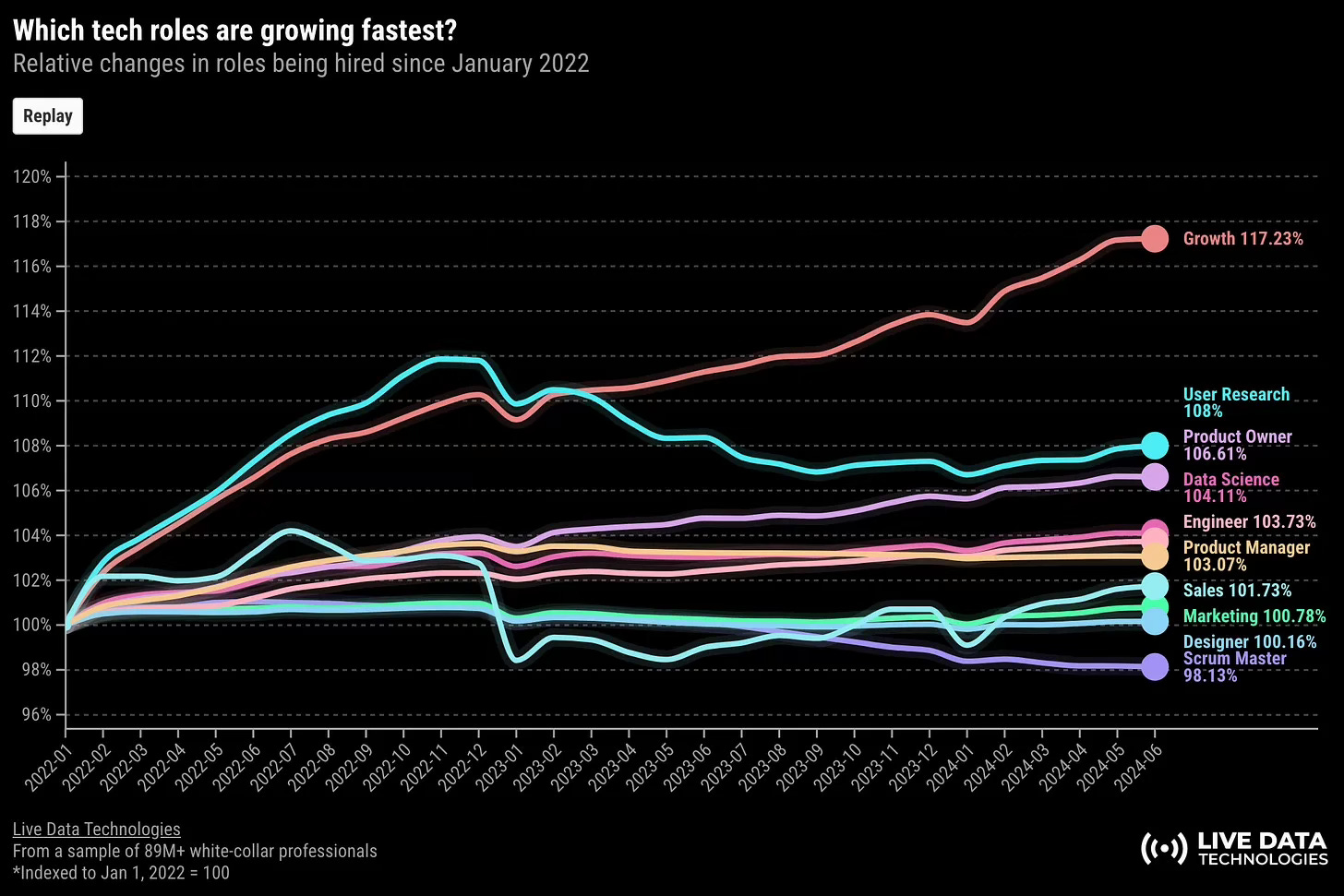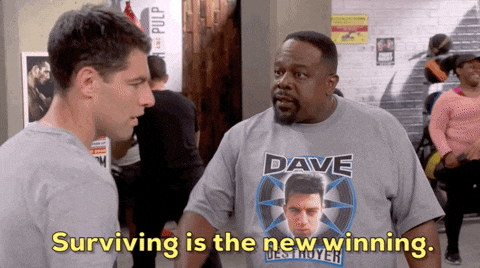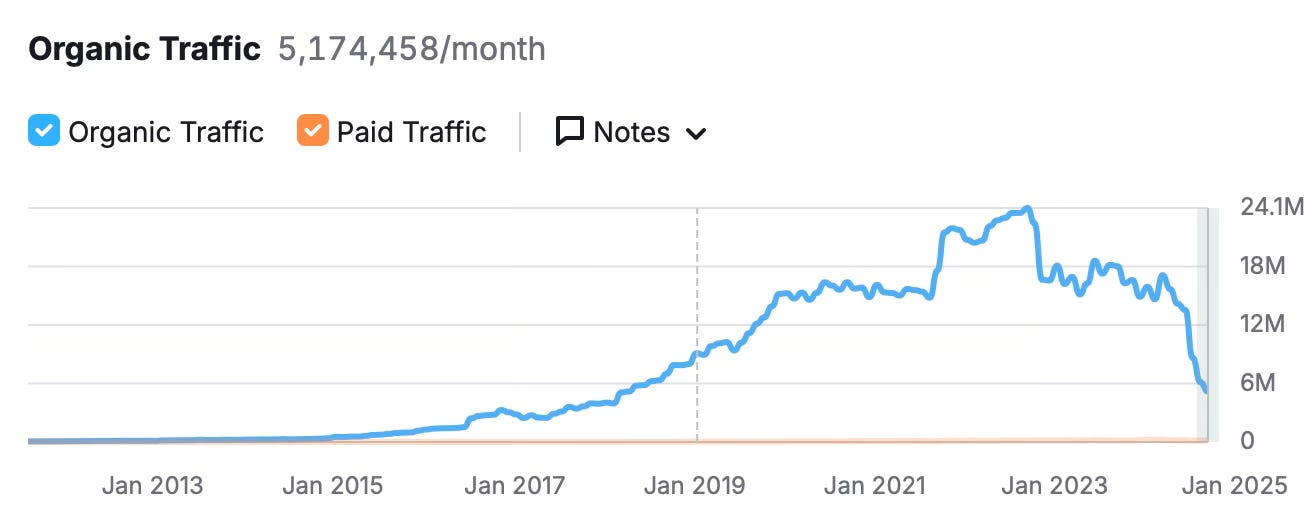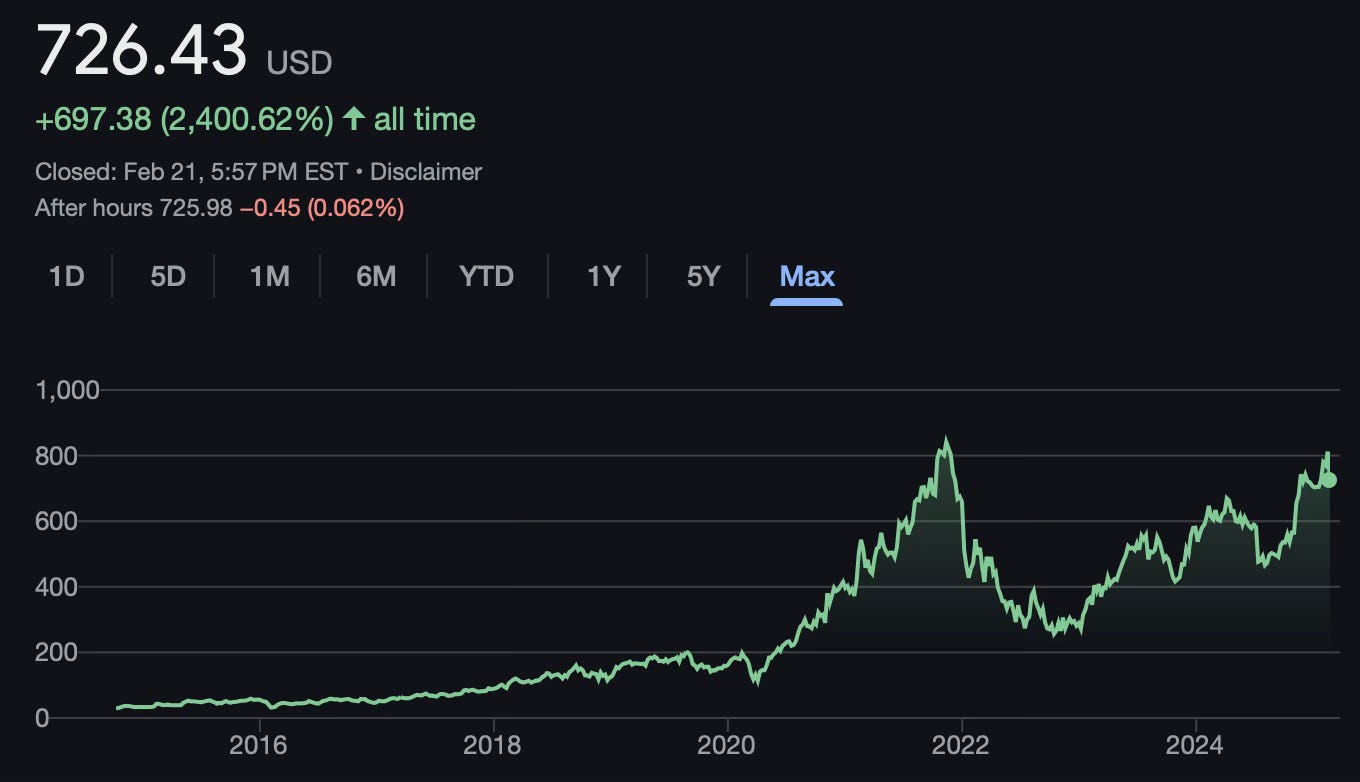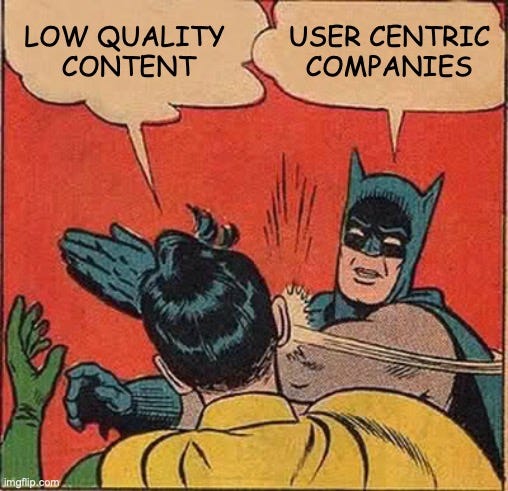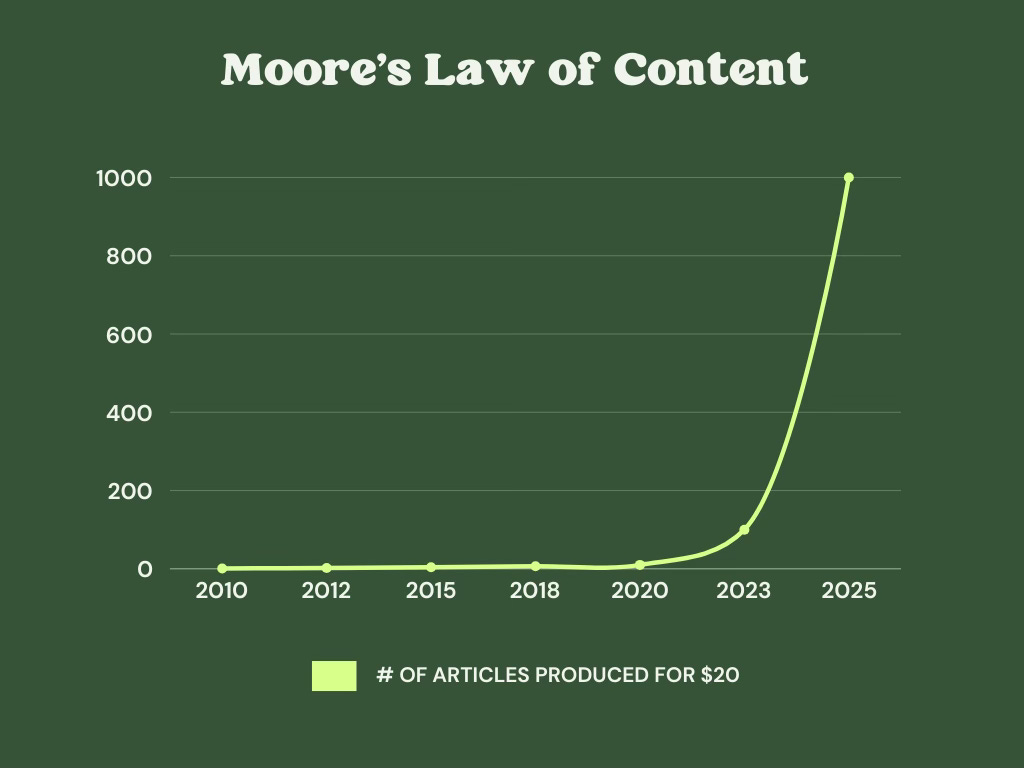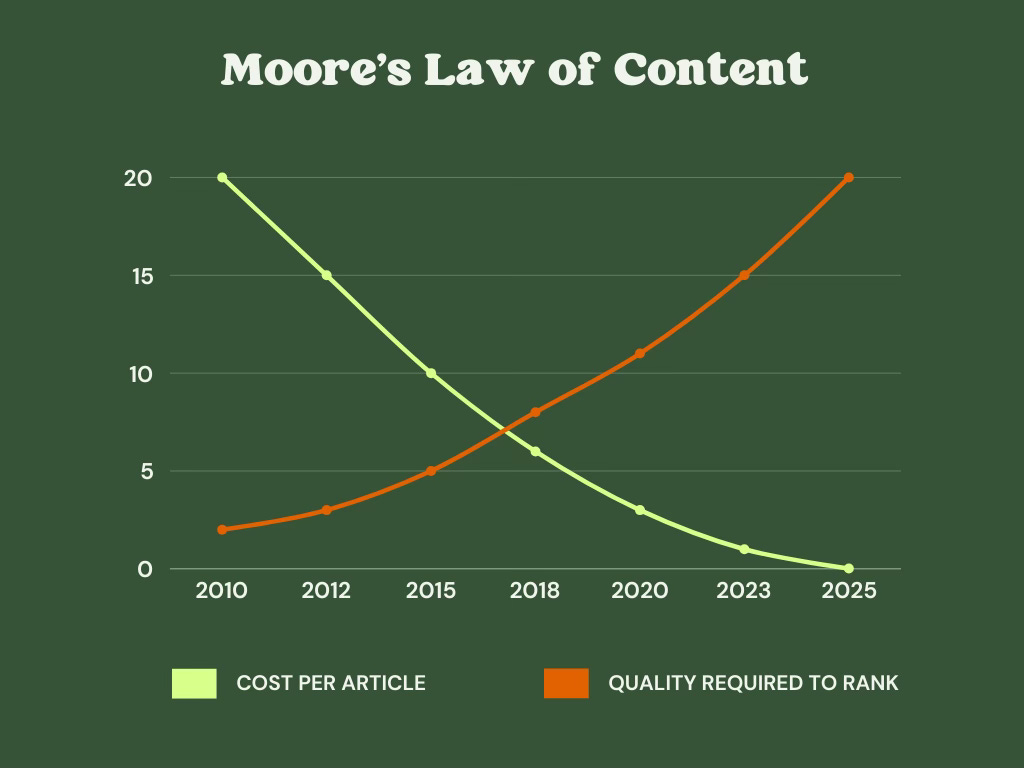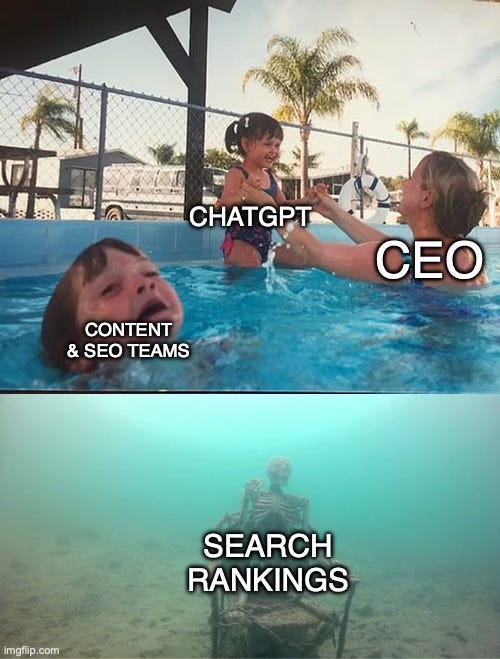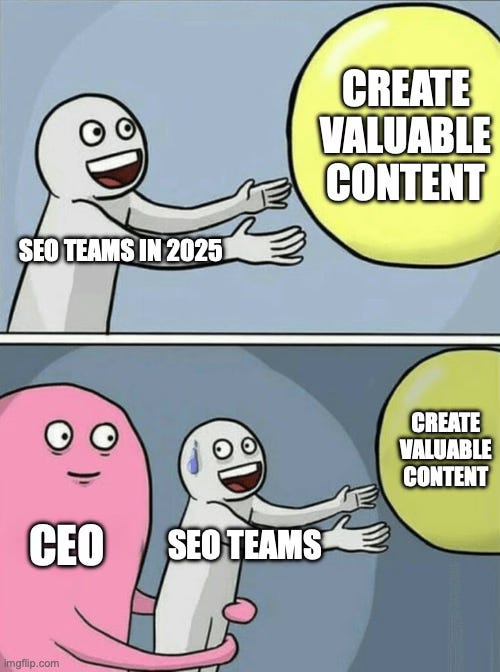7 Lessons From A Decade In SEO
SEO & Content Engineering is about to be the most valuable field in growth. What I learned about the future of search from building, selling, and reinventing my way through SEO 🗺️
🍁 Hey it’s Steven. Welcome to my weekly(ish) field note as I document my adventure adding magic & delight for B2B customers through cosy growth marketing as the Head of Marketing at AirOps 🏕️
When you asked 10 year-old Steven “what do you want to be when you grow up?” He would have said to save animals and be a vet.
What young Steven hadn’t yet realized was that he was a little too squeamish to live that dream.
But he did later realize that he loved math, creativity, and storytelling.
And because of that, there’s thing that’s been on my mind for the last decade.
The acronym SEO (search engine optimization).
And I’ve never been more proud.
SEO has always been this beautiful industry on the edge of science, engineering, data, and creativity.
It’s an accessible industry, not blocked by $100k degrees.
And the best (and worst) part is you know if it’s working.
In this article, I’ll be covering what’s changed over the last decade and what has, and will continue to stay the same.
The industry is becoming more valuable every single day
In 2010, the SEO industry was valued at $10 to $15 billion.
In 2015, it reached $30 billion.
In 2020 reached $79 billion.
And in 2025, it’s valued at around $143.9 billion.
One thing that hasn’t changed is the wild amount of value that a great SEO strategy can drive to a business.
We’ve gone from this weird little industry with a bad reputation, thanks to folks buying backlinks and cold-calling everyone promising higher positions on Google.
To the cool kids on the block.
I experienced this firsthand when our agency got to the first place of Google for the term ‘inbound marketing’.
Seemingly overnight we went from purely outbound marketing to drive awareness to our business, to people coming to us.
It felt… magical.
Why Is SEO Growing?
Three main reasons:
Google has gotten really good at matching a search to a result, heavily increasing the value of each visitor from a Google search.
10 years ago, if you searched inbound marketing in the US or Australia, a large % of the results would be the same. Now localization and context plays a much bigger part.
Google has also introduced a lot of features for eCommerce, like the Merchant Center, local businesses like Google My Business pages, and more, making it easier than ever for a user to find you.
People have gotten better at searching. They’re searching “near me” and for more high intent terms.
Companies are getting better at capturing value for each website visit and they’re willing to pay more.
In 2015, display ads would cost you $3 per 1,000 impressions. Now you’ll be paying $21. A 600% growth over the period, and likely a 1:1 match for how much more revenue websites capture on average.
CPCs from keywords like “cloud POS systems” at $35 per click show that companies can and will pay to rank for keywords because they can earn more than $35 per visit. And if they’re willing to pay $35 for a Google Ad click, it shows how valuable the term must be to rank for organically.
Companies are learning how to capture more and more value and building more complex business models that can extract even more revenue over a customer’s lifetime.
Even the simple pop-up on an eCommerce website to enter your email for 10% off when you land on the page is a clear example of this. Marketers figured out that even though the goal is a purchase, if you can capture the email first, you’re more likely to earn even more revenue.
And as time goes on, the B2B sector has emerged as the primary driver of SEO's increasing economic value.
Y Combinator has pivoted heavily into B2B.
FirstPageSage reported that SEO now delivers a 702% average ROI for B2B SaaS companies with just a 7-month time to break even (heavily outpacing eCommerce at 317% and a 16-month time to break even).
And B2B companies have the unique ability of growing revenues over time.
While you might get bored of buying sunglasses from Gentle Monster, a SaaS company can capture monthly recurring revenue for years. And as more features are added, and as their users’ business grows, customers will upgrade plans and spend more.
The other side is that the value captured from software has higher profit margins, making it so they can spend even more to get the next customer.
And with growth roles having the highest increase in demand since 2022, SEO & content engineering are going to be very popular skills to have.
The Sky Is Still Falling
SEO as a profession is inherently stressful because a lot of what you do is visible to the public.
Anyone can see your strategy.
Your content.
Your rankings.
Your search volume.
Your pivots.
Your mistakes.
And big shifts that are totally out of your control can happen often. Without warning. And can leave your previous strategy in shambles.
We need a badge of honor for surviving this long. 😅
Here are some large Google updates that I have survived (so far):
2011 - Panda - end of all average web pages
2012 - Penguin - end of all average attempts to do back linking
2015 - Mobilegeddon - end of 50% of your traffic
2018 - Speed - end of all slow websites
2022 - Helpful Content Update - end of all unoriginal, anonymous content
2024 - AI in Search - end of all clicks as we know them
Combine this with the fact that anyone can see your search volume graphs, it makes for a sometimes stressful job!
Tactics that you launched 5 years ago that worked will stop working, and people (or your boss) will point them out.
Like HubSpot’s recent spotlight on LinkedIn:
But is the sky actually falling?
While folks share what they can see (the traffic numbers), they can’t see the bottom line.
They don’t see the actual impact of your work. They don’t see the conversion rates, your average order value, or the value created.
Using HubSpot again, while the ‘sky fell’ over in SEO land, it seems the company’s valuation didn’t care.
Meaning that there’s a high chance the traffic lost was all low value traffic.
And that the headlines are nothing more than another overreaction.
I knew I should’ve kept my HubSpot shares back in 2019 😂
User Driven Content Stands The Test Of Time
We all knew this back when we started in SEO.
This is SEO 101.
Google wants the folks who use Google Search to have the best experience possible.
To solve their search in the fastest & most value driven way possible. And they will continue to iterate to keep this true.
This is nothing new. And yet we can often get lost in the sauce. Prioritizing tactics over this fundamental truth.
Let’s look at the above changes from Google’s point of view:
2011 - Not much content? Unlikely to solve a user’s question. Let’s change that.
2012 - Not actually a trusted website? Unlikely to be the best & most trusted place for the user to find information. Let’s change that.
2015 - Have a horrible website experience for folks who are using mobile? Probably not the best place to send mobile traffic. Let’s change that.
2018 - Have a website that is taking ages to load? Not a great user experience. Let’s change that.
2022 - Regurgitating the same content as everyone else and not doing the work in creating original and valuable content? The user is probably after something more valuable. Let’s change that.
2024 - User having to click 10 links to try to solve their query? Let’s change that.
Our understanding of what a good user experience is has shifted so much over the past decade. And it will continue to do so as what’s possible changes.
But one thing has remained the same. If you’re creating content that is user-centric, you’ll outlast every single one of these shifts.
Turns out, as we all thought back in 2015. As time goes on, high quality, user-centric content is continuing to become even more important than ever.
Moore’s Law of Content
The cost of creating content seems to follow Moore’s Law. It becomes twice as cheap to produce the same quality content every 2-years.
Back in 2010, most people could access an okay writer who could do blog posts for as low as $20.
Then having contractors overseas made it easier to create content for $10.
Then the rise of Fiverr made it more accessible than ever to get whole articles created for $5.
Tools were created that rearranged words in an article to make them ‘original’ for a new topic. This got content down to $1 per article.
In 2022, with the initial spread of ChatGPT 3, it dropped to $0.20 an article.
And now in 2025, it is much cheaper at $0.02.
So if it’s becoming increasingly cheap to create content, the only lever you can pull now is quality.
And luckily for us, that’s exactly what our users have always wanted.
Pages with original research see 29.7% higher organic traffic.
Remember those Google updates mentioned above?
They’re in lockstep with the reduction in the cost of content.
As more people create content, our standards rise and the baseline difficulty to rank on Google has increased by the same amount.
We’ve progressed from keyword stuffing, to mass produce low quality pages, to needing to focus on EEAT (Experience, Expertise, Authoritativeness, and Trustworthiness), to the importance of original research.
So how do we balance these two worlds?
And do so in a way that maintains the ROI that led to SEO’s growth to date.
Teams Will Need To Change
I remember back in 2015 we were doing a lead magnet and blog post for a client.
All three of us literally spent 2-days researching and writing.
We were doing things that didn’t scale simply because there was no other choice 😅
Now a decade later we’re in a new world of AI.
And not just in the sense of typing prompts in ChatGPT like ‘create me an article about indoor houseplant soil.’
But AI that can create truly incredible results.
We’re in the world of GTM Engineers and Content Engineers.
Luckily, the goal hasn’t changed.
Just like short-term & short-sighted SEO tactics tried to hack the system to rank quickly, and ultimately always backfired.
Short-term AI tactics are doing the same thing.
Using AI to write a whole blog post with no human oversight and a lazy prompt? R.I.P. 🪦
Using AI to deeply research, cite, provide feedback, and drastically improve content? Hello very valuable position in a company. 📈
The Future Is Human(s In The Loop) 🤖
AI Won’t Replace Humans! Phew 😮💨.
But without AI we can’t compete.
So what’s the solution?
I believe tools like AirOps have it nailed.
They have created a way to allow SEO and content teams to be creative. No more restrictions because we’re non-technical, we can now build and scale our most wild dreams.
The Current Way
As we know, SEO & content teams are not the most funded department by any means.
Often we’re doing a lot with a little. Which is why folks resort to short-term wins, to create space and time for the long-term strategies.
Teams commonly comprise of a number of content writers, and an SEO person.
Rarely would a team have a dedicated researcher or a developer!
The New Way
We still have the same team. 🤯
Bet you didn’t expect that.
But up-skilled.
Rather than your content writer writing the content.
Your content writer becomes a content manager.
Your SEO person becomes a workflow builder.
Together you craft and execute AI workflows that create incredible results.
Take this workflow I built last week.
It turns a video or podcast into an extremely high quality written summary piece that does keyword research and helps you get more views on the content.
Here's how it works:
Content Collection
Ingests your video or podcast content
Analyzes the hosting platform for contextual data
Examines your website to understand audience preferences
Smart Processing
Creates high-quality transcriptions
Uses AI to identify the most impactful moments
Extracts and timestamps the top 10 quotes that resonate with your audience
SEO Intelligence
Discovers relevant search terms your audience is using
Leverages SEMRush to analyze keyword metrics (volume, difficulty, CPC)
Selects optimal targeting opportunities
Content Creation
Weaves together audience insights, research, and your brand voice
Generates an engaging article with key takeaways
Includes actionable steps for your readers
It took me an hour to build.
But now in 3-minutes it gives me an output I can then go through, tweak, and saves me 5+ hours of work per post.
And this evolution of teams learning more has happened throughout the past decade.
Before AHREFs and SEMRush, we used Screaming Frog. Before that we manually looking at ‘people also asked’ on Google searches ourselves.
And when new tools came out, we learned them, we optimized our time, and we improved the quality of our work, and the output of our work.
Before, keyword stuffing used to work. And then we realized that people were on the other side of the searches, and we should write higher quality content. We evolved.
And now AI has arrived. And it’s going anywhere soon.
Yes, some folks started off by producing low quality content in mass.
But many are looking at how we can actually produce the highest quality content we’ve ever created, with expert humans in the loop, all in record time.
I can’t imagine what SEO will look like a decade from now, but one thing I do know is that modern teams will stay modern.
Humans will upskill, and stay in the loop.
And SEO teams will become increasingly more valuable as we don the title of engineers and leverage AI for good.
So who wins in 2025?
Whether you do SEO or content, the winners will be those who are the most creative.
Human experts who write the highest quality prompts, use the deepest knowledge base, and can think of the most creative AI workflows to create outputs no one has ever thought of.
Lashay is such a good example of this. She has the most deeply thought out bottom of the funnel workflows, which means that even though we all have access to the same tools, she’s going to outperform the rest.
It’s been such a great first decade in SEO.
Here’s to the next one. 🥂
I’ll see you next week!
Steven
P.S. Come connect with me on LinkedIn for even more insights during the week.











